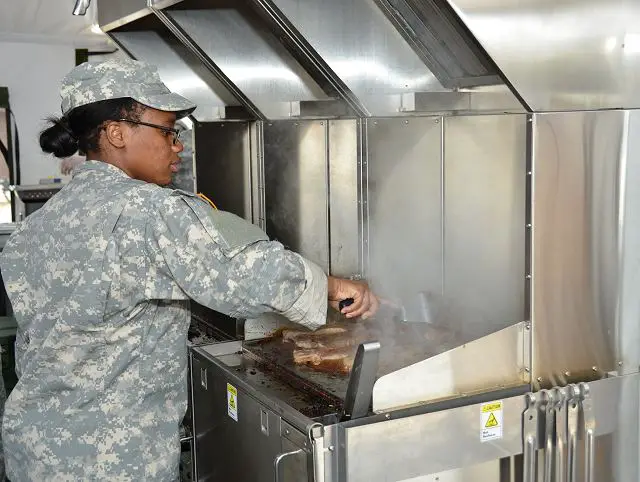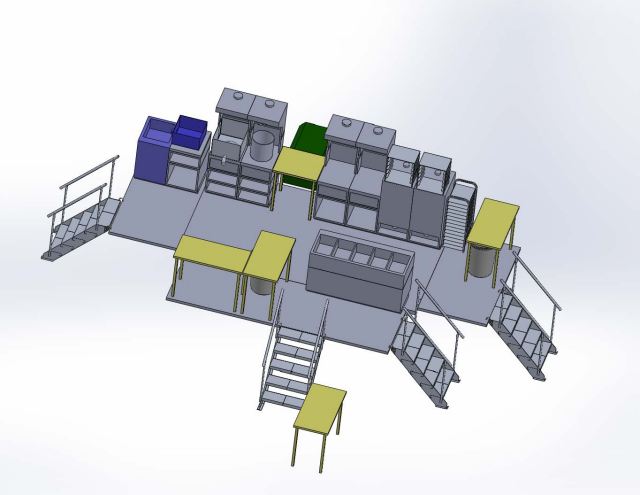|
|
|||
|
Military Defense Industry Technology - BK Battlefield Kitchen
|
|||
|
|
|||
| The U.S. army expects to acquire 1,500 new mobile BK Battlefield Kitchens for 2019. | |||
|
The Battlefield Kitchen, or BK, being developed in a cooperative effort between the Natick Soldier Research, Development and Engineering Center, or NSRDEC, and Product Manager Force Sustainment Systems, or PM FSS, is a self-contained, efficient mobile kitchen that can provide up to three hot meals daily to as many as 300 Soldiers during military operations. The BK can serve a full range of individual and group rations.
|
|||
|
|
|||
 Natick Soldier Research, Development and Engineering Center and Product Manager Force Sustainment Systems are developing a "battlefield kitchen" that will be capable of providing up to three meals daily for as many as 300 Soldiers. Natick Soldier Research, Development and Engineering Center and Product Manager Force Sustainment Systems are developing a "battlefield kitchen" that will be capable of providing up to three meals daily for as many as 300 Soldiers. |
|||
|
|
|||
|
"It's like walking into a restaurant. It's like walking into a real kitchen as opposed to a piece of military equipment," said Joe Jordan, team leader, Food Service Equipment Team, PM FSS/Combat Feeding Directorate, NSRDEC, who added that the BK would provide "a better ability to provide good meals to the Soldiers."
A trailer-mounted system, the BK can be towed by a truck and can be transported by sea, rail or air. It will replace the Mobile Kitchen Trailer, or MKT, which was introduced in the 1970s and uses inefficient open-flame combustion appliances that also vent burner exhaust into the kitchen. The BK features closed-combustion, thermostatically-controlled appliances that will make roasting, grilling, boiling, frying and baking food a cooler, cleaner and quieter process. "In hot ambient conditions, it gets very, very hot inside of the current kitchens," said Tim Benson, program integrator, field services and field feeding, PM FSS. "[The BK is] going to be a healthier environment for the cooks and the customers, not having the burner exhaust going into the kitchen." The process also becomes significantly more energy efficient, according to Benson. |
|||
|
|
|||
 An artist's rendering of the interior of the new "battlefield kitchen" is shown. |
|||
|
|
|||
|
"We're looking for at least a 20-percent improvement in fuel efficiency over the current set of appliances, with an objective of 40 percent," Benson said. "But the main benefit of the appliances is that they're closed combustion. The current appliances are open combustion, which means that all the heat and the exhaust and the noise from burners goes into the kitchen environment, and less [heat goes] into the food."
"Using heat from combustion to directly heat the appliances is so much more efficient than using electrically powered appliances," Jordan said. "A kitchen this size can use a 3kW generator as opposed to a 30kW or 60kW generator required by electric appliances. That allows the kitchens to be truly expeditionary, carrying the generator right onboard the kitchen while still providing a quiet and quality product." The BK appliances aren't only more efficient, they produce better results. "The appliances are designed with heat exchangers that better distribute the heat so that you get more uniform, better quality cooking, on average," Benson said. "You're capturing all that heat that used to escape into the environment, [and] putting it [where] it needs to go." The U.S. Army expects to acquire about 1,500 of the systems, which also include running water, refrigeration and on-board power generation. Development should take place in fiscal years 2016-18, and production is planned to begin in FY 2019.
|
|||
The U.S. army expects to acquire 1,500 new mobile BK Battlefield Kitchens for 2019 11210154
- Posted On















